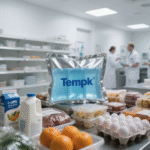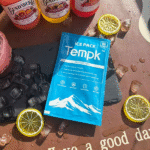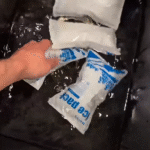Gelo seco vs pacotes de gel PCM é a decisão mais importante quando você envia mercadorias sensíveis à temperatura. Escolha errado e você corre o risco de perder o produto, Questões de conformidade, e clientes insatisfeitos. Escolha certo e você reduz custos, minimizar reclamações, e envie com confiança. Este artigo sintetiza e melhora seus rascunhos anteriores para entregar um guia pronto para 2025.
-
Temperatura & física: como gelo seco vs pacotes de gel PCM realmente diferem em desempenho e pontos de ajuste
-
Segurança & regulamentos: o que os manipuladores devem fazer, e quando as regras de materiais perigosos se aplicam
-
Cenários mais adequados: comida, farmacêutico, e opções de rotas de supermercado eletrônico que realmente funcionam
-
Design de embalagem: isolamento primeiro, segundo refrigerante para maior tempo de espera
-
2025 tendências: reutilizáveis, Isolamento VIP, e hábitos de validação que vencem
Como a temperatura e a física diferem?
Resposta curta: Gelo seco vs pacotes de gel PCM divergem na temperatura e no comportamento da fase. Gelo seco fica perto de -78,5 ° C e sublima em gás, proporcionando resfriamento ultrabaixo. Pacotes de gel PCM são projetados para congelar/derreter em pontos de ajuste alvo (por exemplo −21 °C, +5 °C, ou +20 °C), dando temperatura estável sem gás.
Por que você deveria se importar: Ultrabaixo é ótimo para produtos ultracongelados, mas pode resfriar demais cargas refrigeradas. PCMs mantêm uma banda estreita, ajudando você a evitar choques frios e excursões. Em 2025 operações, que a estabilidade evita retrabalho e reduz reclamações, especialmente no setor farmacêutico e na entrega de kits de refeição.
Como os PCMs de ponto de ajuste evitam o “resfriamento excessivo”?
Durante a mudança de fase, PCMs absorvem calor a uma temperatura quase constante. UM +5 °C PCM armazena em buffer uma carga útil de 2–8 °C perto do meio da faixa, enquanto um PCM de -21 °C protege os alimentos congelados sem empurrá-los para -78 °C. O resultado é um comportamento térmico previsível com manuseio mais seguro e POPs mais fáceis – sem gás CO₂ e sem risco de congelamento para o usuário final.
| Comparação | Gelo seco | Pacotes de gel PCM | Significado prático |
|---|---|---|---|
| Temperatura de trabalho | ~−78,5°C | Ponto de ajuste personalizado (−21°C, +5 °C, +20 °C) | Combine o líquido refrigerante com o rótulo do produto |
| Comportamento de fase | Sublima → gás | Derrete/congela; sem gás | Ventilação vs.. recongelamento simples |
| Status de Hazmat | ONU regulamentada 1845 | Não perigoso | Rótulos/treinamento vs.. fácil manuseio |
| Reutilizar | Uso único | Reutilizável | Menor custo por ciclo |
| Segurança do usuário | EPI necessário | Seguro para tocar | Menos incidentes |
Dicas práticas
-
Faixas de vacina (2–8 ° C.): Usar +5 Pacotes PCM °C, não 0 °C gelo, para evitar choque frio.
-
Alimentos congelados (−30 °C a −10 °C): Use pacotes PCM de −21 °C para rotas curtas/médias; gelo seco para viagens ultrabaixas ou longas.
-
Entregas ao consumidor: Evite etapas de materiais perigosos na porta – prefira PCM, a menos que ≤ −40 °C seja obrigatório.
Caso real: Um expedidor de frutos do mar substituiu o gel misto + gelo seco com PCMs de −21 °C e melhor isolamento para pistas regionais de 24 a 36 horas. As taxas de reclamação caíram, etapas de materiais perigosos desapareceram, e o tempo de reembalagem caiu em um terço, mantendo a integridade da temperatura.
Quando você deve escolher cada método?
Resposta direta: Use gelo seco para remessas ≤−40 °C ou com CO₂ benéfico. Use pacotes de gel PCM para −21 °C congelado, +5 °C refrigerado, ou +18/+22 Temperatura ambiente controlada em °C (CRT), e quando você deseja um manuseio mais simples, sem documentação de materiais perigosos.
Como decidir:
-
Mapear limites de produtos. Se ≤ −40 °C, Use gelo seco.
-
Verifique as restrições. Se materiais perigosos bloquearem sua rota, escolha PCM.
-
Planeje a reutilização. Programas PCM reduzem custos recorrentes.
Design de embalagem: isolamento antes do refrigerante
Reduzir o ganho de calor é mais importante do que adicionar refrigerante. VIP (painéis isolados a vácuo) supera a espuma espessa, permitindo caixas menores e tempos de espera mais longos. Posicione o refrigerante onde o calor entra (parte superior/laterais) e minimizar o headspace.
| Fator de embalagem | O que fazer | Por que | Impacto |
|---|---|---|---|
| Dimensionamento da caixa | Espaço do tamanho certo | Menos ar = retenção mais longa | Menor frete |
| Isolamento | Adicionar VIP | Reduzir o ganho de calor | Prolongar a duração |
| Colocação do refrigerante | Parte superior/laterais | Combinar caminho de calor | Temperatura estável |
| Condicionamento | Siga o POP | Evitar excursões | Consistência |
Mini “Como fazer”:
-
Pré-estabilizar carga útil.
-
Condicionar PCM ou pesar gelo seco.
-
Carregue com headspace mínimo.
-
Verifique com registradores de dados.
Segurança e conformidade no transporte
Gelo seco: Precisa de embalagem ventilada, rotulagem, e manuseio treinado. Nunca faça uma embalagem de gelo seco hermética. Marque “Gelo Seco/Dióxido de Carbono, Sólido,”com a ONU 1845 e massa líquida (kg).
Pacotes PCM: Geralmente não perigoso – basta seguir a SDS do fornecedor e o POP de condicionamento.
Segurança Essentials:
-
Use luvas isoladas e ventilação para gelo seco.
-
Confirme os limites de CO₂ da transportadora.
-
Para caixas de consumo, use apenas PCMs não perigosos.
2025 Tendências da cadeia fria
Sustentabilidade & inovação: PCMs reutilizáveis e isolamento VIP estão se padronizando no transporte global. Os expedidores agora otimizam −21 °C e +5 Programas de °C para eliminar etapas de materiais perigosos, reduzir o desperdício, e validar o desempenho com registradores de dados.
Principais desenvolvimentos
-
Resfriamento híbrido: A combinação de PCMs com pequenas cargas de gelo seco prolonga a duração.
-
Nova química PCM: Maior calor latente, pontos de ajuste mais apertados, tempos de espera mais longos.
-
Cultura de validação: Testes de pista verão/inverno como prática padrão.
Insight de mercado: Mercearia eletrônica, Biologics, e alimentos especiais impulsionam o aumento da demanda por -21 °C e +5 °CPCMs. Embalagens reutilizáveis e programas de ciclo fechado proporcionam ganhos em custos e ESG, enquanto o gelo seco permanece crítico para uso ≤−40 °C.
Perguntas frequentes
Q1: Um pacote de gel PCM é igual a gelo seco?
Não. Um pacote de gel PCM é um refrigerante de mudança de fase reutilizável a uma temperatura específica; gelo seco é CO₂ sólido a -78,5 °C.
Q2: Quando devo escolher PCMs de −21 °C em vez de gelo seco?
Para produtos congelados que não necessitam de ≤−40 °C, escolha PCMs de −21 °C para segurança, remessa sem materiais perigosos.
Q3: Posso voar com gelo seco?
Sim, dentro dos limites da companhia aérea e do correio, com ventilação e etiquetagem. PCMs não têm essa restrição.
Q4: O que causa a maioria dos problemas de remessa de PCM?
Condicionamento inadequado e excesso de espaço de ar. Siga estritamente os POPs.
Q5: Os PCMs são seguros para clientes finais??
Sim. Eles estão selados, não tóxico, e reutilizável.
Resumo & Recomendações
Pontos -chave: Gelo seco vs pacotes de gel PCM diferem em temperatura, segurança, e regras. O gelo seco cobre pistas ≤ −40 °C, mas adiciona materiais perigosos. PCMs suportam -21 °C a +22 °C com segurança e eficiência. Otimize o isolamento antes de aumentar o refrigerante.
PRÓXIMOS PASSOS:
-
Mapear requisitos de temperatura do SKU.
-
Escolha o líquido refrigerante de menor risco que atenda a eles.
-
Validar pistas por temporada.
CTA: Consulte um especialista em cadeia de frio da Tempk para otimizar seus pontos de ajuste e embalagem.
Sobre Tempk
Criamos práticas, embalagens validadas para cadeia de frio – embalagens de gel PCM reutilizáveis (−21°C, +5 °C, +18/+22 °C), Retipadores VIP, e POPs testados para produtos congelados, refrigerado, e pistas CRT. Nós nos concentramos na conformidade, desempenho, e eficiência de custos.
























